Analyzing CLABSI Risks: A Case Study of Joseph Russo's CVAD Care
VerifiedAdded on 2023/04/21
|10
|2763
|491
Case Study
AI Summary
This case study examines the case of Joseph Russo, who developed a central line-associated bloodstream infection (CLABSI) and occlusion following the insertion of a central venous access device (CVAD). The essay discusses the risk factors associated with CVADs, focusing on the causes and prevention of CLABSI and occlusion. It highlights the importance of proper nursing care, including aseptic techniques, regular assessment, and dietary modifications to minimize infection risks and promote patient recovery. Management strategies such as thrombolytic agents and anticoagulant prophylaxis are explored, along with the need for careful monitoring and physician consultation. The study concludes by emphasizing the significance of preventive measures and comprehensive care in managing CVAD-related complications.

Running head: CASE STUDY ON JOSEPH RUSSO
Case study on Joseph Russo
Name of the Student
Name of the University
Author Note
Case study on Joseph Russo
Name of the Student
Name of the University
Author Note
Paraphrase This Document
Need a fresh take? Get an instant paraphrase of this document with our AI Paraphraser
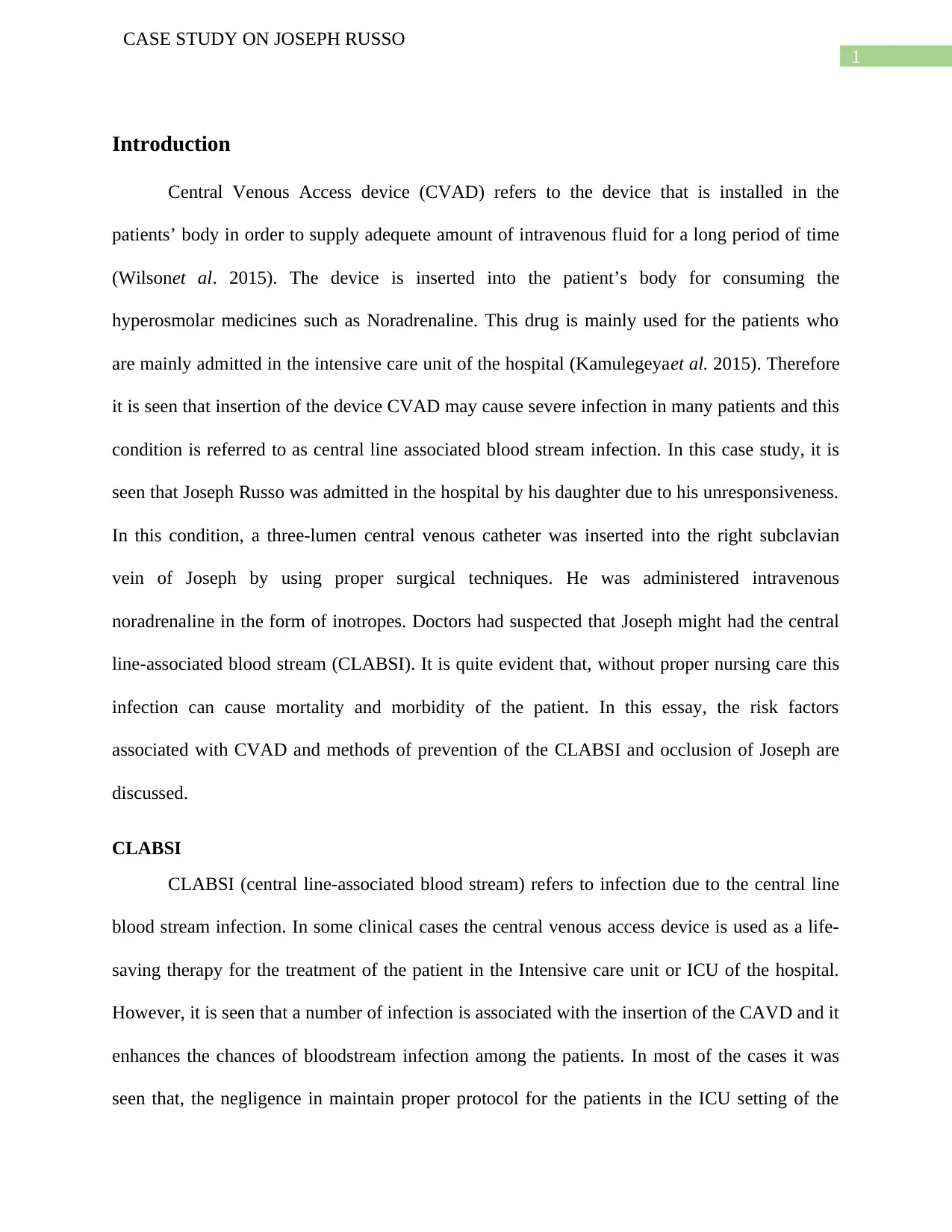
1
CASE STUDY ON JOSEPH RUSSO
Introduction
Central Venous Access device (CVAD) refers to the device that is installed in the
patients’ body in order to supply adequete amount of intravenous fluid for a long period of time
(Wilsonet al. 2015). The device is inserted into the patient’s body for consuming the
hyperosmolar medicines such as Noradrenaline. This drug is mainly used for the patients who
are mainly admitted in the intensive care unit of the hospital (Kamulegeyaet al. 2015). Therefore
it is seen that insertion of the device CVAD may cause severe infection in many patients and this
condition is referred to as central line associated blood stream infection. In this case study, it is
seen that Joseph Russo was admitted in the hospital by his daughter due to his unresponsiveness.
In this condition, a three-lumen central venous catheter was inserted into the right subclavian
vein of Joseph by using proper surgical techniques. He was administered intravenous
noradrenaline in the form of inotropes. Doctors had suspected that Joseph might had the central
line-associated blood stream (CLABSI). It is quite evident that, without proper nursing care this
infection can cause mortality and morbidity of the patient. In this essay, the risk factors
associated with CVAD and methods of prevention of the CLABSI and occlusion of Joseph are
discussed.
CLABSI
CLABSI (central line-associated blood stream) refers to infection due to the central line
blood stream infection. In some clinical cases the central venous access device is used as a life-
saving therapy for the treatment of the patient in the Intensive care unit or ICU of the hospital.
However, it is seen that a number of infection is associated with the insertion of the CAVD and it
enhances the chances of bloodstream infection among the patients. In most of the cases it was
seen that, the negligence in maintain proper protocol for the patients in the ICU setting of the
CASE STUDY ON JOSEPH RUSSO
Introduction
Central Venous Access device (CVAD) refers to the device that is installed in the
patients’ body in order to supply adequete amount of intravenous fluid for a long period of time
(Wilsonet al. 2015). The device is inserted into the patient’s body for consuming the
hyperosmolar medicines such as Noradrenaline. This drug is mainly used for the patients who
are mainly admitted in the intensive care unit of the hospital (Kamulegeyaet al. 2015). Therefore
it is seen that insertion of the device CVAD may cause severe infection in many patients and this
condition is referred to as central line associated blood stream infection. In this case study, it is
seen that Joseph Russo was admitted in the hospital by his daughter due to his unresponsiveness.
In this condition, a three-lumen central venous catheter was inserted into the right subclavian
vein of Joseph by using proper surgical techniques. He was administered intravenous
noradrenaline in the form of inotropes. Doctors had suspected that Joseph might had the central
line-associated blood stream (CLABSI). It is quite evident that, without proper nursing care this
infection can cause mortality and morbidity of the patient. In this essay, the risk factors
associated with CVAD and methods of prevention of the CLABSI and occlusion of Joseph are
discussed.
CLABSI
CLABSI (central line-associated blood stream) refers to infection due to the central line
blood stream infection. In some clinical cases the central venous access device is used as a life-
saving therapy for the treatment of the patient in the Intensive care unit or ICU of the hospital.
However, it is seen that a number of infection is associated with the insertion of the CAVD and it
enhances the chances of bloodstream infection among the patients. In most of the cases it was
seen that, the negligence in maintain proper protocol for the patients in the ICU setting of the
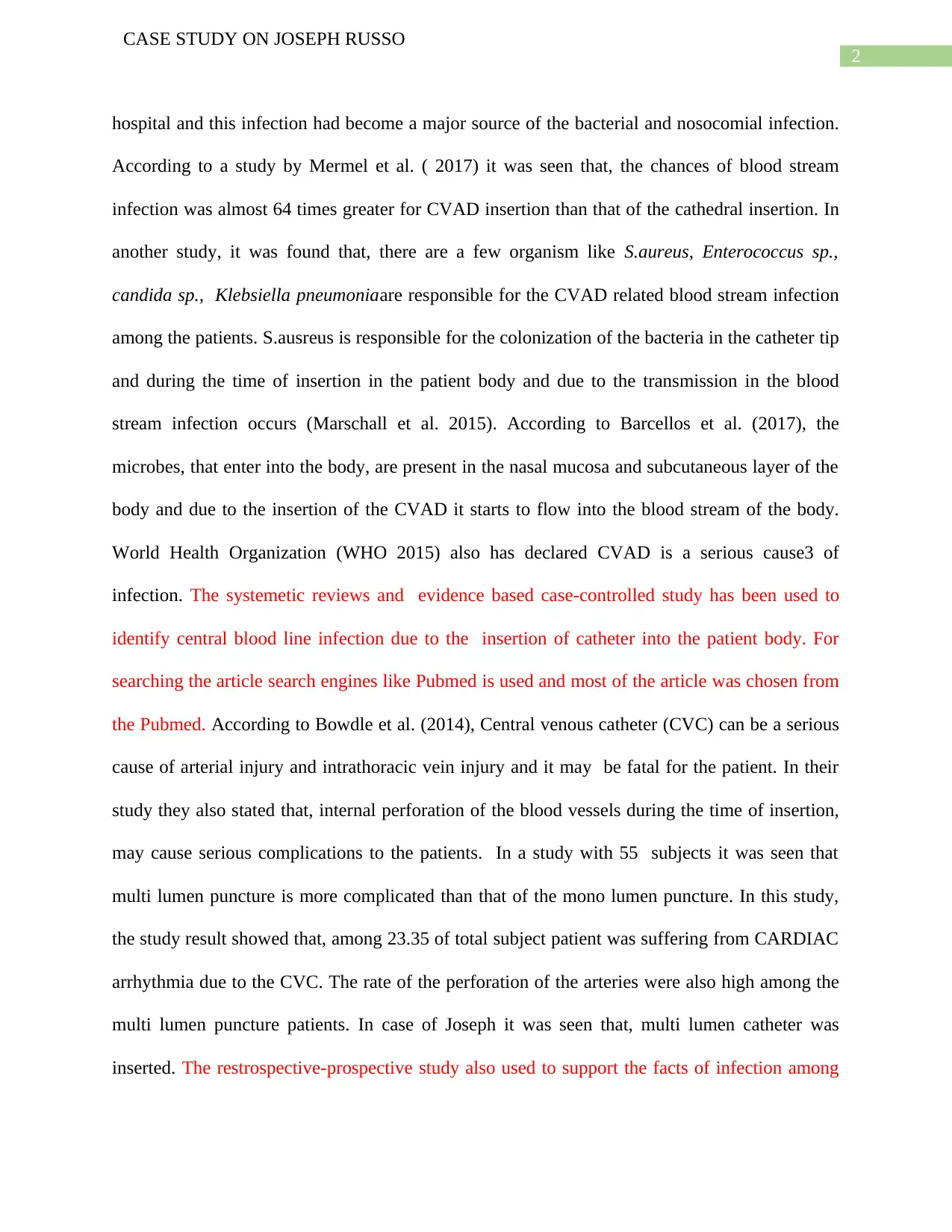
2
CASE STUDY ON JOSEPH RUSSO
hospital and this infection had become a major source of the bacterial and nosocomial infection.
According to a study by Mermel et al. ( 2017) it was seen that, the chances of blood stream
infection was almost 64 times greater for CVAD insertion than that of the cathedral insertion. In
another study, it was found that, there are a few organism like S.aureus, Enterococcus sp.,
candida sp., Klebsiella pneumoniaare responsible for the CVAD related blood stream infection
among the patients. S.ausreus is responsible for the colonization of the bacteria in the catheter tip
and during the time of insertion in the patient body and due to the transmission in the blood
stream infection occurs (Marschall et al. 2015). According to Barcellos et al. (2017), the
microbes, that enter into the body, are present in the nasal mucosa and subcutaneous layer of the
body and due to the insertion of the CVAD it starts to flow into the blood stream of the body.
World Health Organization (WHO 2015) also has declared CVAD is a serious cause3 of
infection. The systemetic reviews and evidence based case-controlled study has been used to
identify central blood line infection due to the insertion of catheter into the patient body. For
searching the article search engines like Pubmed is used and most of the article was chosen from
the Pubmed. According to Bowdle et al. (2014), Central venous catheter (CVC) can be a serious
cause of arterial injury and intrathoracic vein injury and it may be fatal for the patient. In their
study they also stated that, internal perforation of the blood vessels during the time of insertion,
may cause serious complications to the patients. In a study with 55 subjects it was seen that
multi lumen puncture is more complicated than that of the mono lumen puncture. In this study,
the study result showed that, among 23.35 of total subject patient was suffering from CARDIAC
arrhythmia due to the CVC. The rate of the perforation of the arteries were also high among the
multi lumen puncture patients. In case of Joseph it was seen that, multi lumen catheter was
inserted. The restrospective-prospective study also used to support the facts of infection among
CASE STUDY ON JOSEPH RUSSO
hospital and this infection had become a major source of the bacterial and nosocomial infection.
According to a study by Mermel et al. ( 2017) it was seen that, the chances of blood stream
infection was almost 64 times greater for CVAD insertion than that of the cathedral insertion. In
another study, it was found that, there are a few organism like S.aureus, Enterococcus sp.,
candida sp., Klebsiella pneumoniaare responsible for the CVAD related blood stream infection
among the patients. S.ausreus is responsible for the colonization of the bacteria in the catheter tip
and during the time of insertion in the patient body and due to the transmission in the blood
stream infection occurs (Marschall et al. 2015). According to Barcellos et al. (2017), the
microbes, that enter into the body, are present in the nasal mucosa and subcutaneous layer of the
body and due to the insertion of the CVAD it starts to flow into the blood stream of the body.
World Health Organization (WHO 2015) also has declared CVAD is a serious cause3 of
infection. The systemetic reviews and evidence based case-controlled study has been used to
identify central blood line infection due to the insertion of catheter into the patient body. For
searching the article search engines like Pubmed is used and most of the article was chosen from
the Pubmed. According to Bowdle et al. (2014), Central venous catheter (CVC) can be a serious
cause of arterial injury and intrathoracic vein injury and it may be fatal for the patient. In their
study they also stated that, internal perforation of the blood vessels during the time of insertion,
may cause serious complications to the patients. In a study with 55 subjects it was seen that
multi lumen puncture is more complicated than that of the mono lumen puncture. In this study,
the study result showed that, among 23.35 of total subject patient was suffering from CARDIAC
arrhythmia due to the CVC. The rate of the perforation of the arteries were also high among the
multi lumen puncture patients. In case of Joseph it was seen that, multi lumen catheter was
inserted. The restrospective-prospective study also used to support the facts of infection among
⊘ This is a preview!⊘
Do you want full access?
Subscribe today to unlock all pages.

Trusted by 1+ million students worldwide
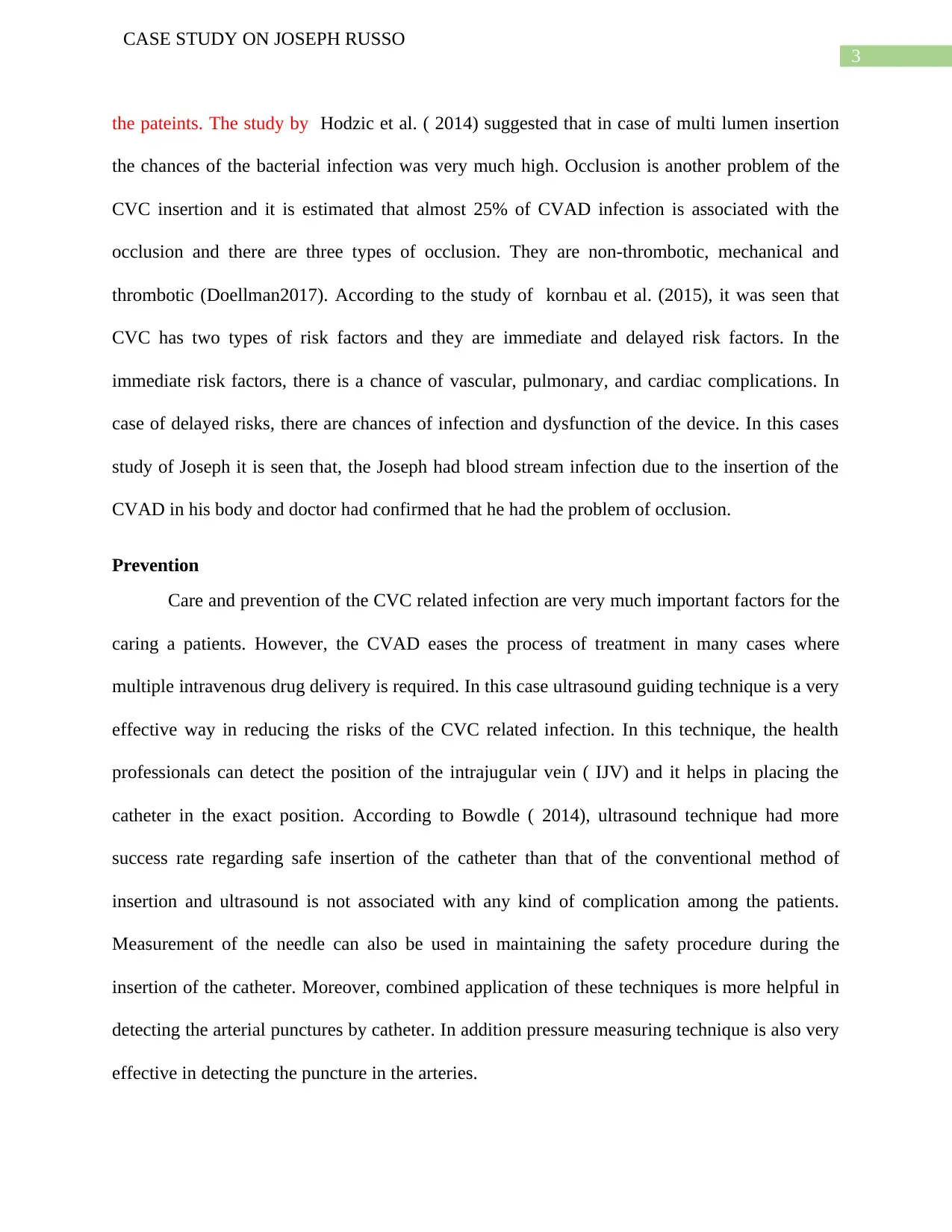
3
CASE STUDY ON JOSEPH RUSSO
the pateints. The study by Hodzic et al. ( 2014) suggested that in case of multi lumen insertion
the chances of the bacterial infection was very much high. Occlusion is another problem of the
CVC insertion and it is estimated that almost 25% of CVAD infection is associated with the
occlusion and there are three types of occlusion. They are non-thrombotic, mechanical and
thrombotic (Doellman2017). According to the study of kornbau et al. (2015), it was seen that
CVC has two types of risk factors and they are immediate and delayed risk factors. In the
immediate risk factors, there is a chance of vascular, pulmonary, and cardiac complications. In
case of delayed risks, there are chances of infection and dysfunction of the device. In this cases
study of Joseph it is seen that, the Joseph had blood stream infection due to the insertion of the
CVAD in his body and doctor had confirmed that he had the problem of occlusion.
Prevention
Care and prevention of the CVC related infection are very much important factors for the
caring a patients. However, the CVAD eases the process of treatment in many cases where
multiple intravenous drug delivery is required. In this case ultrasound guiding technique is a very
effective way in reducing the risks of the CVC related infection. In this technique, the health
professionals can detect the position of the intrajugular vein ( IJV) and it helps in placing the
catheter in the exact position. According to Bowdle ( 2014), ultrasound technique had more
success rate regarding safe insertion of the catheter than that of the conventional method of
insertion and ultrasound is not associated with any kind of complication among the patients.
Measurement of the needle can also be used in maintaining the safety procedure during the
insertion of the catheter. Moreover, combined application of these techniques is more helpful in
detecting the arterial punctures by catheter. In addition pressure measuring technique is also very
effective in detecting the puncture in the arteries.
CASE STUDY ON JOSEPH RUSSO
the pateints. The study by Hodzic et al. ( 2014) suggested that in case of multi lumen insertion
the chances of the bacterial infection was very much high. Occlusion is another problem of the
CVC insertion and it is estimated that almost 25% of CVAD infection is associated with the
occlusion and there are three types of occlusion. They are non-thrombotic, mechanical and
thrombotic (Doellman2017). According to the study of kornbau et al. (2015), it was seen that
CVC has two types of risk factors and they are immediate and delayed risk factors. In the
immediate risk factors, there is a chance of vascular, pulmonary, and cardiac complications. In
case of delayed risks, there are chances of infection and dysfunction of the device. In this cases
study of Joseph it is seen that, the Joseph had blood stream infection due to the insertion of the
CVAD in his body and doctor had confirmed that he had the problem of occlusion.
Prevention
Care and prevention of the CVC related infection are very much important factors for the
caring a patients. However, the CVAD eases the process of treatment in many cases where
multiple intravenous drug delivery is required. In this case ultrasound guiding technique is a very
effective way in reducing the risks of the CVC related infection. In this technique, the health
professionals can detect the position of the intrajugular vein ( IJV) and it helps in placing the
catheter in the exact position. According to Bowdle ( 2014), ultrasound technique had more
success rate regarding safe insertion of the catheter than that of the conventional method of
insertion and ultrasound is not associated with any kind of complication among the patients.
Measurement of the needle can also be used in maintaining the safety procedure during the
insertion of the catheter. Moreover, combined application of these techniques is more helpful in
detecting the arterial punctures by catheter. In addition pressure measuring technique is also very
effective in detecting the puncture in the arteries.
Paraphrase This Document
Need a fresh take? Get an instant paraphrase of this document with our AI Paraphraser
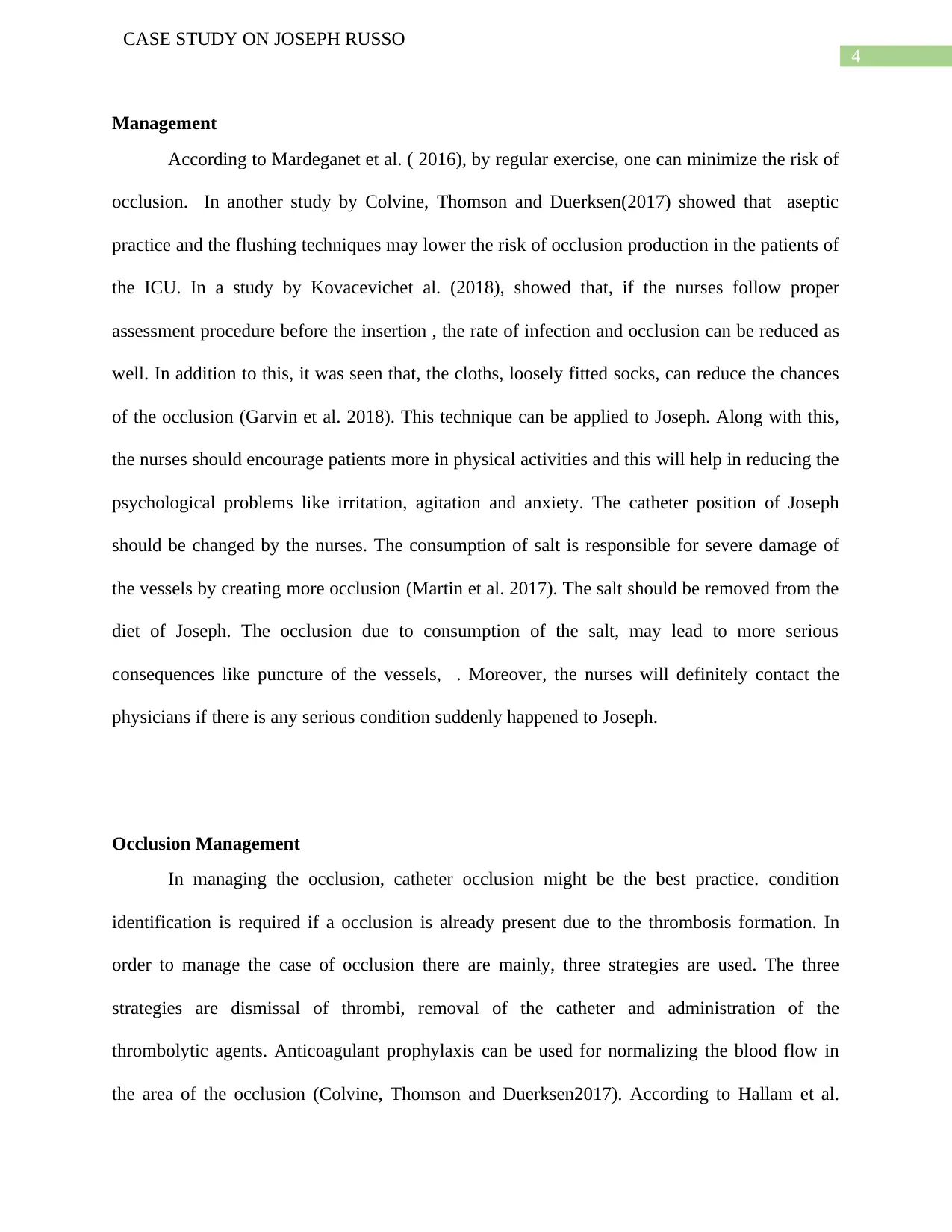
4
CASE STUDY ON JOSEPH RUSSO
Management
According to Mardeganet et al. ( 2016), by regular exercise, one can minimize the risk of
occlusion. In another study by Colvine, Thomson and Duerksen(2017) showed that aseptic
practice and the flushing techniques may lower the risk of occlusion production in the patients of
the ICU. In a study by Kovacevichet al. (2018), showed that, if the nurses follow proper
assessment procedure before the insertion , the rate of infection and occlusion can be reduced as
well. In addition to this, it was seen that, the cloths, loosely fitted socks, can reduce the chances
of the occlusion (Garvin et al. 2018). This technique can be applied to Joseph. Along with this,
the nurses should encourage patients more in physical activities and this will help in reducing the
psychological problems like irritation, agitation and anxiety. The catheter position of Joseph
should be changed by the nurses. The consumption of salt is responsible for severe damage of
the vessels by creating more occlusion (Martin et al. 2017). The salt should be removed from the
diet of Joseph. The occlusion due to consumption of the salt, may lead to more serious
consequences like puncture of the vessels, . Moreover, the nurses will definitely contact the
physicians if there is any serious condition suddenly happened to Joseph.
Occlusion Management
In managing the occlusion, catheter occlusion might be the best practice. condition
identification is required if a occlusion is already present due to the thrombosis formation. In
order to manage the case of occlusion there are mainly, three strategies are used. The three
strategies are dismissal of thrombi, removal of the catheter and administration of the
thrombolytic agents. Anticoagulant prophylaxis can be used for normalizing the blood flow in
the area of the occlusion (Colvine, Thomson and Duerksen2017). According to Hallam et al.
CASE STUDY ON JOSEPH RUSSO
Management
According to Mardeganet et al. ( 2016), by regular exercise, one can minimize the risk of
occlusion. In another study by Colvine, Thomson and Duerksen(2017) showed that aseptic
practice and the flushing techniques may lower the risk of occlusion production in the patients of
the ICU. In a study by Kovacevichet al. (2018), showed that, if the nurses follow proper
assessment procedure before the insertion , the rate of infection and occlusion can be reduced as
well. In addition to this, it was seen that, the cloths, loosely fitted socks, can reduce the chances
of the occlusion (Garvin et al. 2018). This technique can be applied to Joseph. Along with this,
the nurses should encourage patients more in physical activities and this will help in reducing the
psychological problems like irritation, agitation and anxiety. The catheter position of Joseph
should be changed by the nurses. The consumption of salt is responsible for severe damage of
the vessels by creating more occlusion (Martin et al. 2017). The salt should be removed from the
diet of Joseph. The occlusion due to consumption of the salt, may lead to more serious
consequences like puncture of the vessels, . Moreover, the nurses will definitely contact the
physicians if there is any serious condition suddenly happened to Joseph.
Occlusion Management
In managing the occlusion, catheter occlusion might be the best practice. condition
identification is required if a occlusion is already present due to the thrombosis formation. In
order to manage the case of occlusion there are mainly, three strategies are used. The three
strategies are dismissal of thrombi, removal of the catheter and administration of the
thrombolytic agents. Anticoagulant prophylaxis can be used for normalizing the blood flow in
the area of the occlusion (Colvine, Thomson and Duerksen2017). According to Hallam et al.
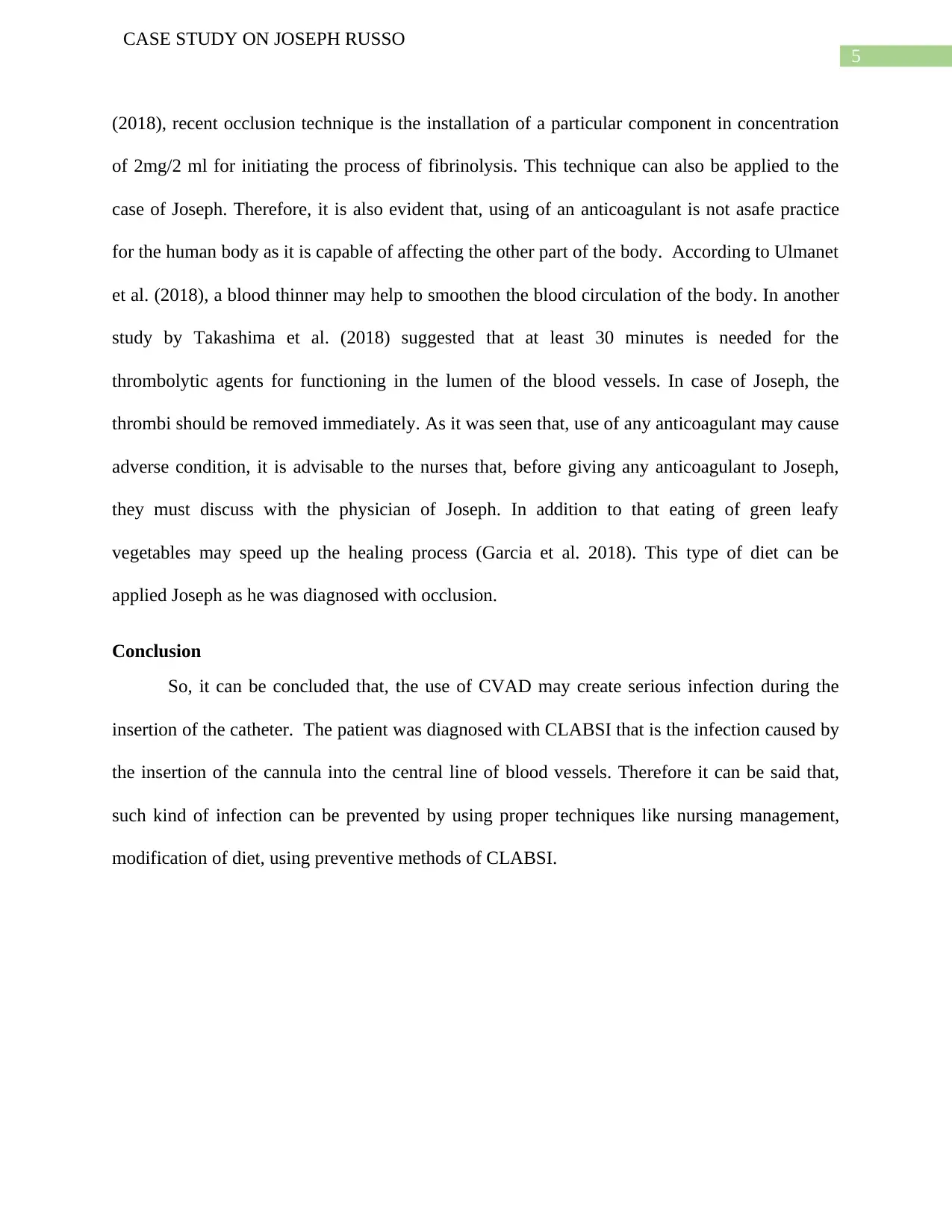
5
CASE STUDY ON JOSEPH RUSSO
(2018), recent occlusion technique is the installation of a particular component in concentration
of 2mg/2 ml for initiating the process of fibrinolysis. This technique can also be applied to the
case of Joseph. Therefore, it is also evident that, using of an anticoagulant is not asafe practice
for the human body as it is capable of affecting the other part of the body. According to Ulmanet
et al. (2018), a blood thinner may help to smoothen the blood circulation of the body. In another
study by Takashima et al. (2018) suggested that at least 30 minutes is needed for the
thrombolytic agents for functioning in the lumen of the blood vessels. In case of Joseph, the
thrombi should be removed immediately. As it was seen that, use of any anticoagulant may cause
adverse condition, it is advisable to the nurses that, before giving any anticoagulant to Joseph,
they must discuss with the physician of Joseph. In addition to that eating of green leafy
vegetables may speed up the healing process (Garcia et al. 2018). This type of diet can be
applied Joseph as he was diagnosed with occlusion.
Conclusion
So, it can be concluded that, the use of CVAD may create serious infection during the
insertion of the catheter. The patient was diagnosed with CLABSI that is the infection caused by
the insertion of the cannula into the central line of blood vessels. Therefore it can be said that,
such kind of infection can be prevented by using proper techniques like nursing management,
modification of diet, using preventive methods of CLABSI.
CASE STUDY ON JOSEPH RUSSO
(2018), recent occlusion technique is the installation of a particular component in concentration
of 2mg/2 ml for initiating the process of fibrinolysis. This technique can also be applied to the
case of Joseph. Therefore, it is also evident that, using of an anticoagulant is not asafe practice
for the human body as it is capable of affecting the other part of the body. According to Ulmanet
et al. (2018), a blood thinner may help to smoothen the blood circulation of the body. In another
study by Takashima et al. (2018) suggested that at least 30 minutes is needed for the
thrombolytic agents for functioning in the lumen of the blood vessels. In case of Joseph, the
thrombi should be removed immediately. As it was seen that, use of any anticoagulant may cause
adverse condition, it is advisable to the nurses that, before giving any anticoagulant to Joseph,
they must discuss with the physician of Joseph. In addition to that eating of green leafy
vegetables may speed up the healing process (Garcia et al. 2018). This type of diet can be
applied Joseph as he was diagnosed with occlusion.
Conclusion
So, it can be concluded that, the use of CVAD may create serious infection during the
insertion of the catheter. The patient was diagnosed with CLABSI that is the infection caused by
the insertion of the cannula into the central line of blood vessels. Therefore it can be said that,
such kind of infection can be prevented by using proper techniques like nursing management,
modification of diet, using preventive methods of CLABSI.
⊘ This is a preview!⊘
Do you want full access?
Subscribe today to unlock all pages.

Trusted by 1+ million students worldwide
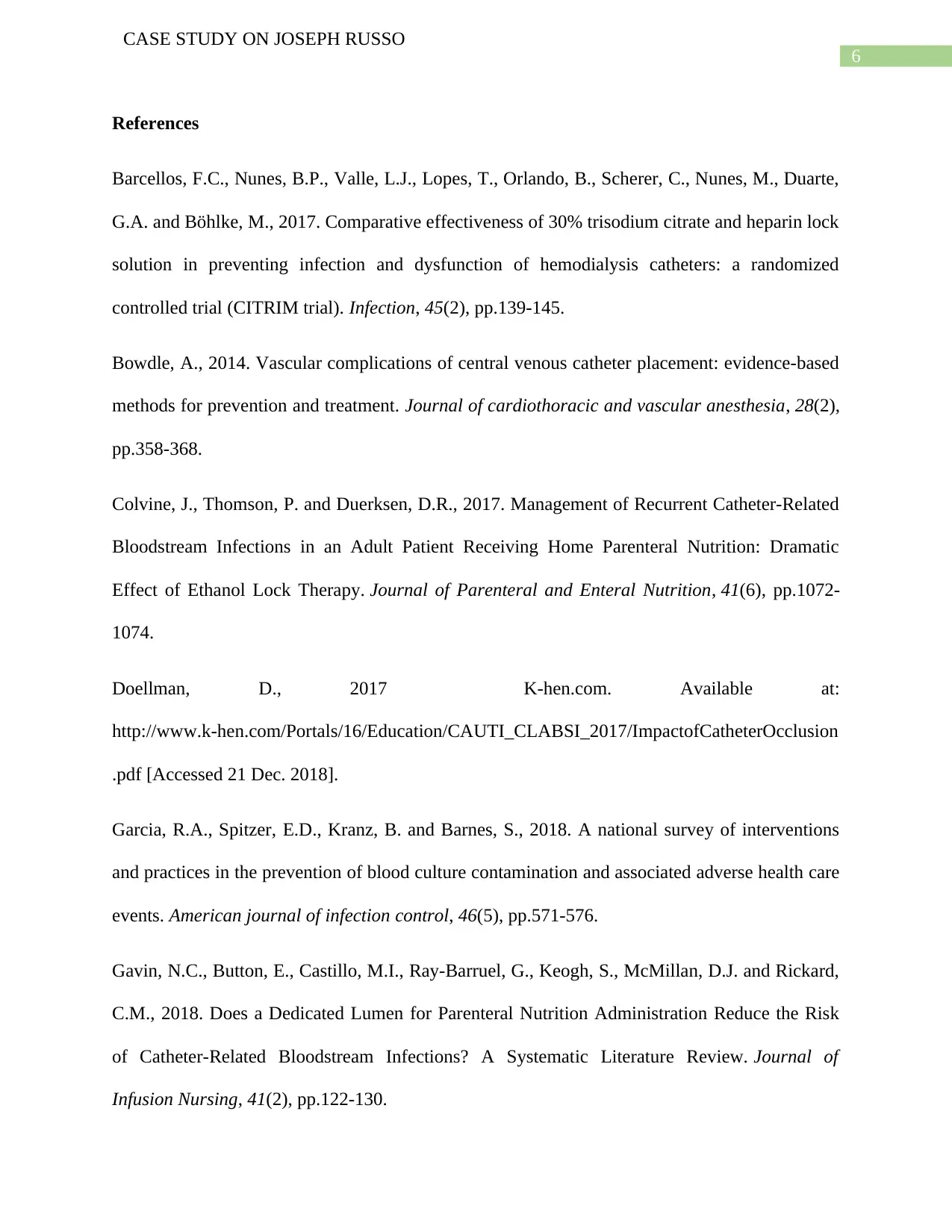
6
CASE STUDY ON JOSEPH RUSSO
References
Barcellos, F.C., Nunes, B.P., Valle, L.J., Lopes, T., Orlando, B., Scherer, C., Nunes, M., Duarte,
G.A. and Böhlke, M., 2017. Comparative effectiveness of 30% trisodium citrate and heparin lock
solution in preventing infection and dysfunction of hemodialysis catheters: a randomized
controlled trial (CITRIM trial). Infection, 45(2), pp.139-145.
Bowdle, A., 2014. Vascular complications of central venous catheter placement: evidence-based
methods for prevention and treatment. Journal of cardiothoracic and vascular anesthesia, 28(2),
pp.358-368.
Colvine, J., Thomson, P. and Duerksen, D.R., 2017. Management of Recurrent Catheter‐Related
Bloodstream Infections in an Adult Patient Receiving Home Parenteral Nutrition: Dramatic
Effect of Ethanol Lock Therapy. Journal of Parenteral and Enteral Nutrition, 41(6), pp.1072-
1074.
Doellman, D., 2017 K-hen.com. Available at:
http://www.k-hen.com/Portals/16/Education/CAUTI_CLABSI_2017/ImpactofCatheterOcclusion
.pdf [Accessed 21 Dec. 2018].
Garcia, R.A., Spitzer, E.D., Kranz, B. and Barnes, S., 2018. A national survey of interventions
and practices in the prevention of blood culture contamination and associated adverse health care
events. American journal of infection control, 46(5), pp.571-576.
Gavin, N.C., Button, E., Castillo, M.I., Ray-Barruel, G., Keogh, S., McMillan, D.J. and Rickard,
C.M., 2018. Does a Dedicated Lumen for Parenteral Nutrition Administration Reduce the Risk
of Catheter-Related Bloodstream Infections? A Systematic Literature Review. Journal of
Infusion Nursing, 41(2), pp.122-130.
CASE STUDY ON JOSEPH RUSSO
References
Barcellos, F.C., Nunes, B.P., Valle, L.J., Lopes, T., Orlando, B., Scherer, C., Nunes, M., Duarte,
G.A. and Böhlke, M., 2017. Comparative effectiveness of 30% trisodium citrate and heparin lock
solution in preventing infection and dysfunction of hemodialysis catheters: a randomized
controlled trial (CITRIM trial). Infection, 45(2), pp.139-145.
Bowdle, A., 2014. Vascular complications of central venous catheter placement: evidence-based
methods for prevention and treatment. Journal of cardiothoracic and vascular anesthesia, 28(2),
pp.358-368.
Colvine, J., Thomson, P. and Duerksen, D.R., 2017. Management of Recurrent Catheter‐Related
Bloodstream Infections in an Adult Patient Receiving Home Parenteral Nutrition: Dramatic
Effect of Ethanol Lock Therapy. Journal of Parenteral and Enteral Nutrition, 41(6), pp.1072-
1074.
Doellman, D., 2017 K-hen.com. Available at:
http://www.k-hen.com/Portals/16/Education/CAUTI_CLABSI_2017/ImpactofCatheterOcclusion
.pdf [Accessed 21 Dec. 2018].
Garcia, R.A., Spitzer, E.D., Kranz, B. and Barnes, S., 2018. A national survey of interventions
and practices in the prevention of blood culture contamination and associated adverse health care
events. American journal of infection control, 46(5), pp.571-576.
Gavin, N.C., Button, E., Castillo, M.I., Ray-Barruel, G., Keogh, S., McMillan, D.J. and Rickard,
C.M., 2018. Does a Dedicated Lumen for Parenteral Nutrition Administration Reduce the Risk
of Catheter-Related Bloodstream Infections? A Systematic Literature Review. Journal of
Infusion Nursing, 41(2), pp.122-130.
Paraphrase This Document
Need a fresh take? Get an instant paraphrase of this document with our AI Paraphraser
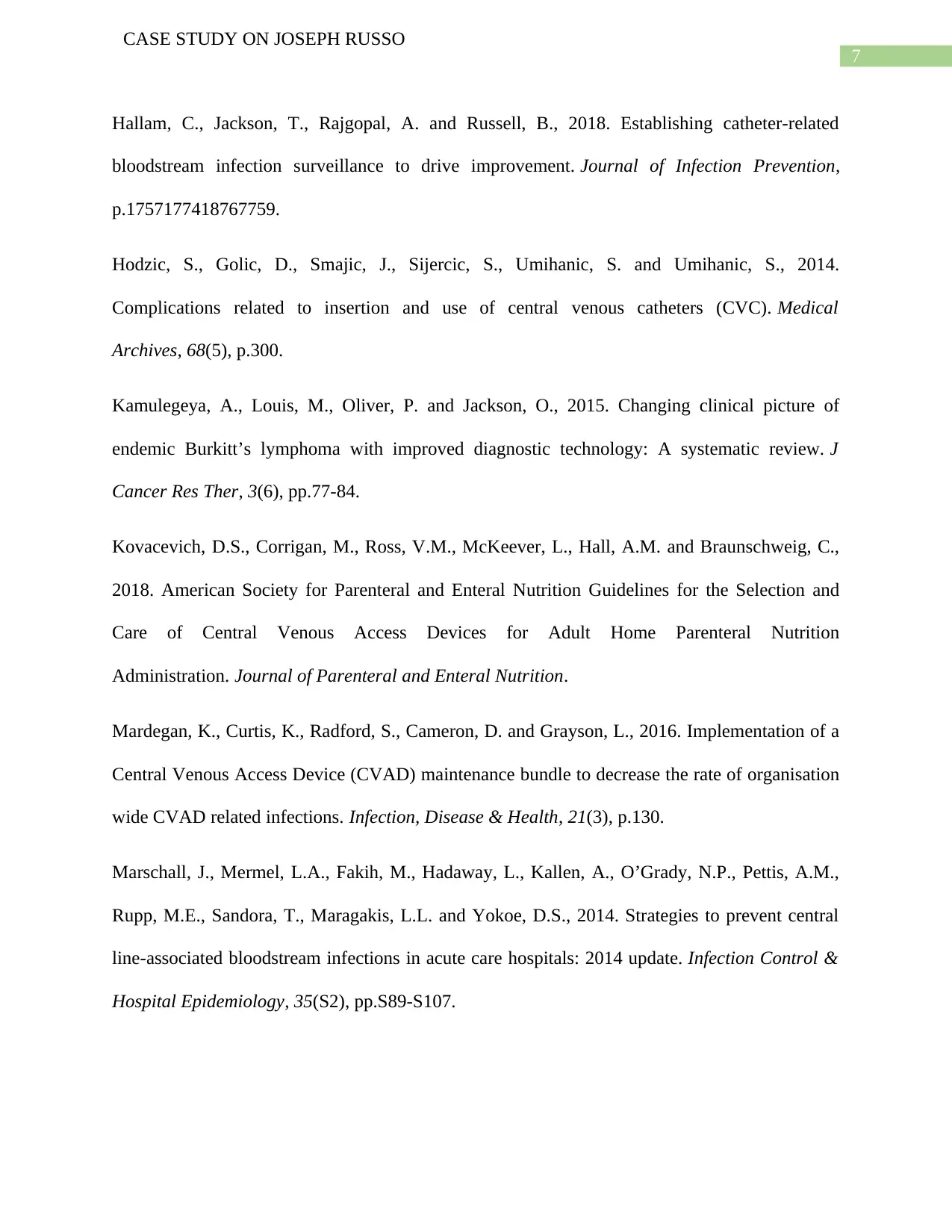
7
CASE STUDY ON JOSEPH RUSSO
Hallam, C., Jackson, T., Rajgopal, A. and Russell, B., 2018. Establishing catheter-related
bloodstream infection surveillance to drive improvement. Journal of Infection Prevention,
p.1757177418767759.
Hodzic, S., Golic, D., Smajic, J., Sijercic, S., Umihanic, S. and Umihanic, S., 2014.
Complications related to insertion and use of central venous catheters (CVC). Medical
Archives, 68(5), p.300.
Kamulegeya, A., Louis, M., Oliver, P. and Jackson, O., 2015. Changing clinical picture of
endemic Burkitt’s lymphoma with improved diagnostic technology: A systematic review. J
Cancer Res Ther, 3(6), pp.77-84.
Kovacevich, D.S., Corrigan, M., Ross, V.M., McKeever, L., Hall, A.M. and Braunschweig, C.,
2018. American Society for Parenteral and Enteral Nutrition Guidelines for the Selection and
Care of Central Venous Access Devices for Adult Home Parenteral Nutrition
Administration. Journal of Parenteral and Enteral Nutrition.
Mardegan, K., Curtis, K., Radford, S., Cameron, D. and Grayson, L., 2016. Implementation of a
Central Venous Access Device (CVAD) maintenance bundle to decrease the rate of organisation
wide CVAD related infections. Infection, Disease & Health, 21(3), p.130.
Marschall, J., Mermel, L.A., Fakih, M., Hadaway, L., Kallen, A., O’Grady, N.P., Pettis, A.M.,
Rupp, M.E., Sandora, T., Maragakis, L.L. and Yokoe, D.S., 2014. Strategies to prevent central
line-associated bloodstream infections in acute care hospitals: 2014 update. Infection Control &
Hospital Epidemiology, 35(S2), pp.S89-S107.
CASE STUDY ON JOSEPH RUSSO
Hallam, C., Jackson, T., Rajgopal, A. and Russell, B., 2018. Establishing catheter-related
bloodstream infection surveillance to drive improvement. Journal of Infection Prevention,
p.1757177418767759.
Hodzic, S., Golic, D., Smajic, J., Sijercic, S., Umihanic, S. and Umihanic, S., 2014.
Complications related to insertion and use of central venous catheters (CVC). Medical
Archives, 68(5), p.300.
Kamulegeya, A., Louis, M., Oliver, P. and Jackson, O., 2015. Changing clinical picture of
endemic Burkitt’s lymphoma with improved diagnostic technology: A systematic review. J
Cancer Res Ther, 3(6), pp.77-84.
Kovacevich, D.S., Corrigan, M., Ross, V.M., McKeever, L., Hall, A.M. and Braunschweig, C.,
2018. American Society for Parenteral and Enteral Nutrition Guidelines for the Selection and
Care of Central Venous Access Devices for Adult Home Parenteral Nutrition
Administration. Journal of Parenteral and Enteral Nutrition.
Mardegan, K., Curtis, K., Radford, S., Cameron, D. and Grayson, L., 2016. Implementation of a
Central Venous Access Device (CVAD) maintenance bundle to decrease the rate of organisation
wide CVAD related infections. Infection, Disease & Health, 21(3), p.130.
Marschall, J., Mermel, L.A., Fakih, M., Hadaway, L., Kallen, A., O’Grady, N.P., Pettis, A.M.,
Rupp, M.E., Sandora, T., Maragakis, L.L. and Yokoe, D.S., 2014. Strategies to prevent central
line-associated bloodstream infections in acute care hospitals: 2014 update. Infection Control &
Hospital Epidemiology, 35(S2), pp.S89-S107.
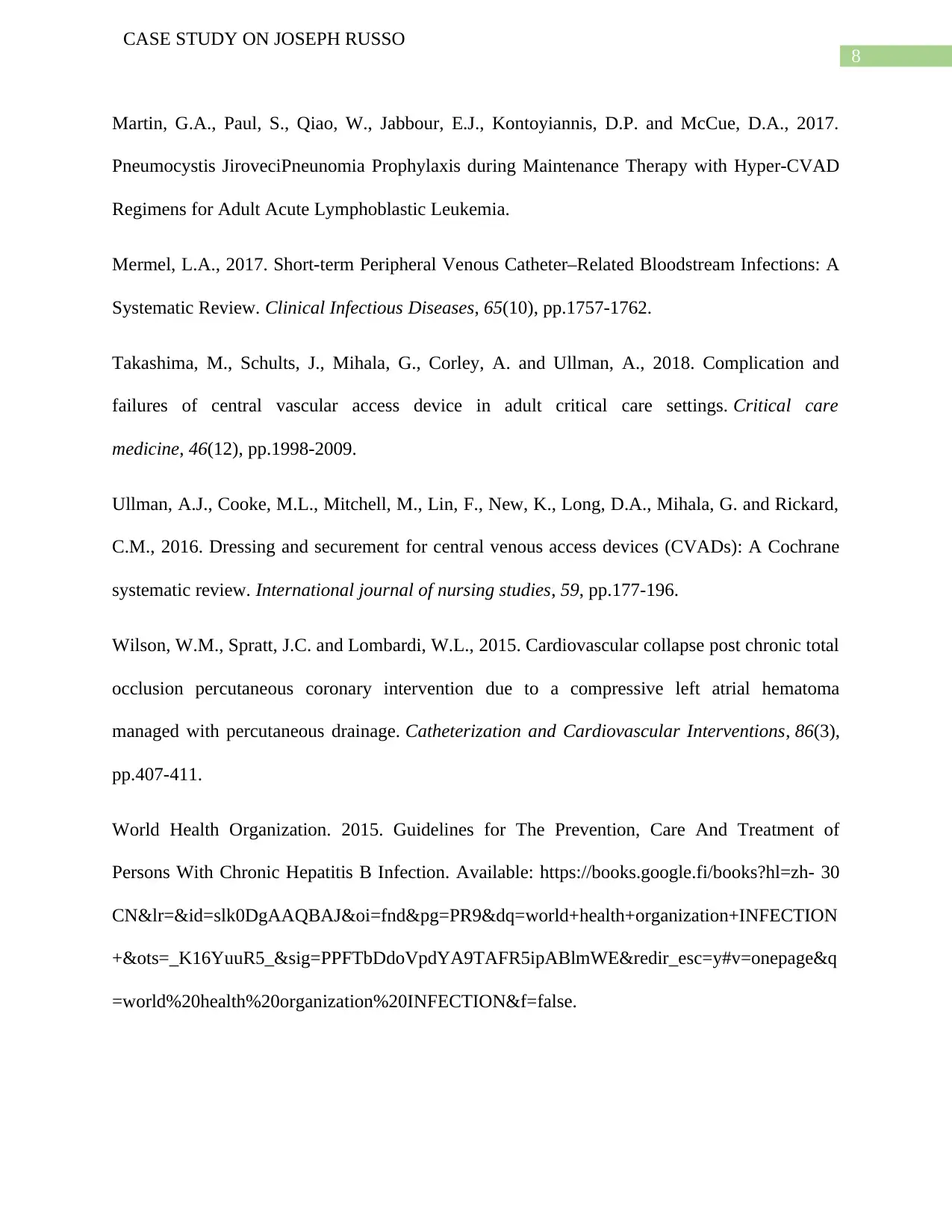
8
CASE STUDY ON JOSEPH RUSSO
Martin, G.A., Paul, S., Qiao, W., Jabbour, E.J., Kontoyiannis, D.P. and McCue, D.A., 2017.
Pneumocystis JiroveciPneunomia Prophylaxis during Maintenance Therapy with Hyper-CVAD
Regimens for Adult Acute Lymphoblastic Leukemia.
Mermel, L.A., 2017. Short-term Peripheral Venous Catheter–Related Bloodstream Infections: A
Systematic Review. Clinical Infectious Diseases, 65(10), pp.1757-1762.
Takashima, M., Schults, J., Mihala, G., Corley, A. and Ullman, A., 2018. Complication and
failures of central vascular access device in adult critical care settings. Critical care
medicine, 46(12), pp.1998-2009.
Ullman, A.J., Cooke, M.L., Mitchell, M., Lin, F., New, K., Long, D.A., Mihala, G. and Rickard,
C.M., 2016. Dressing and securement for central venous access devices (CVADs): A Cochrane
systematic review. International journal of nursing studies, 59, pp.177-196.
Wilson, W.M., Spratt, J.C. and Lombardi, W.L., 2015. Cardiovascular collapse post chronic total
occlusion percutaneous coronary intervention due to a compressive left atrial hematoma
managed with percutaneous drainage. Catheterization and Cardiovascular Interventions, 86(3),
pp.407-411.
World Health Organization. 2015. Guidelines for The Prevention, Care And Treatment of
Persons With Chronic Hepatitis B Infection. Available: https://books.google.fi/books?hl=zh- 30
CN&lr=&id=slk0DgAAQBAJ&oi=fnd&pg=PR9&dq=world+health+organization+INFECTION
+&ots=_K16YuuR5_&sig=PPFTbDdoVpdYA9TAFR5ipABlmWE&redir_esc=y#v=onepage&q
=world%20health%20organization%20INFECTION&f=false.
CASE STUDY ON JOSEPH RUSSO
Martin, G.A., Paul, S., Qiao, W., Jabbour, E.J., Kontoyiannis, D.P. and McCue, D.A., 2017.
Pneumocystis JiroveciPneunomia Prophylaxis during Maintenance Therapy with Hyper-CVAD
Regimens for Adult Acute Lymphoblastic Leukemia.
Mermel, L.A., 2017. Short-term Peripheral Venous Catheter–Related Bloodstream Infections: A
Systematic Review. Clinical Infectious Diseases, 65(10), pp.1757-1762.
Takashima, M., Schults, J., Mihala, G., Corley, A. and Ullman, A., 2018. Complication and
failures of central vascular access device in adult critical care settings. Critical care
medicine, 46(12), pp.1998-2009.
Ullman, A.J., Cooke, M.L., Mitchell, M., Lin, F., New, K., Long, D.A., Mihala, G. and Rickard,
C.M., 2016. Dressing and securement for central venous access devices (CVADs): A Cochrane
systematic review. International journal of nursing studies, 59, pp.177-196.
Wilson, W.M., Spratt, J.C. and Lombardi, W.L., 2015. Cardiovascular collapse post chronic total
occlusion percutaneous coronary intervention due to a compressive left atrial hematoma
managed with percutaneous drainage. Catheterization and Cardiovascular Interventions, 86(3),
pp.407-411.
World Health Organization. 2015. Guidelines for The Prevention, Care And Treatment of
Persons With Chronic Hepatitis B Infection. Available: https://books.google.fi/books?hl=zh- 30
CN&lr=&id=slk0DgAAQBAJ&oi=fnd&pg=PR9&dq=world+health+organization+INFECTION
+&ots=_K16YuuR5_&sig=PPFTbDdoVpdYA9TAFR5ipABlmWE&redir_esc=y#v=onepage&q
=world%20health%20organization%20INFECTION&f=false.
⊘ This is a preview!⊘
Do you want full access?
Subscribe today to unlock all pages.

Trusted by 1+ million students worldwide

9
CASE STUDY ON JOSEPH RUSSO
CASE STUDY ON JOSEPH RUSSO
1 out of 10
Related Documents
Your All-in-One AI-Powered Toolkit for Academic Success.
+13062052269
info@desklib.com
Available 24*7 on WhatsApp / Email
![[object Object]](/_next/static/media/star-bottom.7253800d.svg)
Unlock your academic potential
Copyright © 2020–2025 A2Z Services. All Rights Reserved. Developed and managed by ZUCOL.





